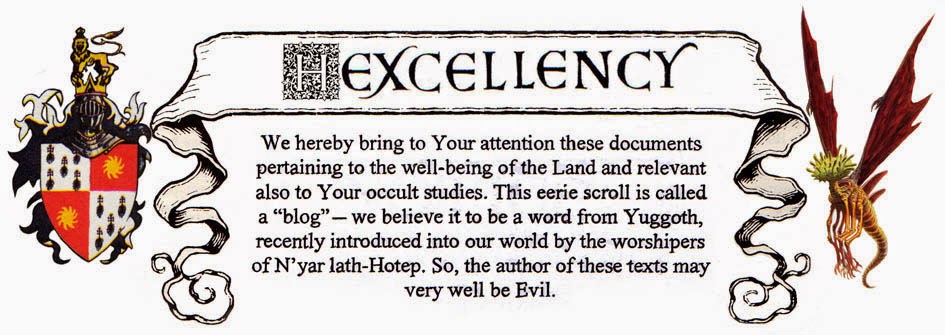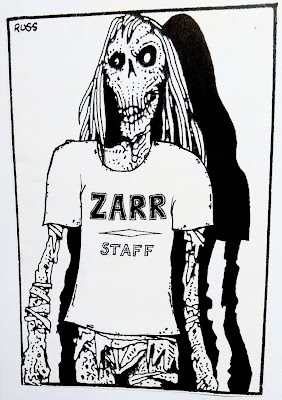Huthak the barbarian is having brunch with Rausche
the druid and Grimbald the thief at a lovely establishment called The
Priestess and the Sorcerer. They are busy discussing the crazy things
that some of their comrades have done as of late, detailed in my previous post: Descent Into Malbolge.
The three are trying to decide if these guys are uncanny mavericks, or
just, y’know, insane.
Suddenly, whoosh, a djinn appears right next to
their table.
The other patrons are flabbergasted, and some even
fall down to their knees. “Three
wishes! Three wishes!”
they plead. To which the djinn replies, “It’s
never been three wishes – I’ve been saying this for hundreds of
years – it is three dishes.
I am a chef, you see. My name is Prospero Sharma. They call me the
Cook of the Gods. I cook for Queen Titania, for Corellon Larethian,
and sometimes for Bahamut, the platinum dragon.”
The djinn
orders everybody out, except for Huthak, Rausche, and Grimbald. He
tells the three that he desperately needs their help. He says, “My
elephant, Spark, has been taken by a malevolent jerk who calls
himself Zarr. This guy is a world-class nutcase. His real name is
Bardish Dong. He’s a puny magic-user, like, not that powerful. He’s
been cursed with a skull head, and decided to use that to his
advantage by creating a whole new persona for himself, and pretending
to be a lich. He found an old crown, wears bone white gloves, and
dresses in ancient, tattered robes. And he changed his name to Zarr
the lich. But he is not
a lich. He is an ordinary magic-user, and really not that strong. His
major assets are two magic items: a Wand of Teleportation, and a
Censer of Controlling Fire Elementals. He made his lair inside mount
Igrá, a volcano, and attracted a few elementals to do his bidding.
The rest is just gullible Humans and credulous Drows and Troglodytes
who really believe to be in the service of an actual lich.”
“Why us?”
asks the barbarian.
“I am, alas,
allergic to magic items,” says Prospero, “and since the three of
you don’t carry any such items, you are the perfect candidates:
I’ll be able to carry you through the air, to mount Igrá, and then
inside the wormholes of living fire that crisscross the core of that
volcano, all the way to Zarr’s Sanctum. But once we get to where
this faux lich keeps my poor old Spark, you’re gonna be on your
own. Zarr knows my weakness – and scatters magic items around his
lair. I will be powerless in there; you shall have to defeat Zarr’s
followers and free my elephant all by yourselves. I am told that
whenever a battle seems lost, Zarr uses this damn Wand of
Teleportation and flees the scene.”
“But what’s
in it for us?” enquires the druid.
The djinn
answers, “As I said before, I can grant you three dishes. The Dish
of Strength,
the Dish
of Agility,
and the Dish
of Fortitude.
Each dish will improve your physical abilities differently, and the
effects on mortals can remain for up to a year and a half. I can only
prepare one Dish
of Strength
per year, and only one Dish
of Agility,
and only one Dish
of Fortitude.
You decide between yourselves who gets to consume which meal. Bring
your own wine!”
Prospero conjures up a life-sized image of Spark.
“This
is who you’re looking for. He is very dear to my heart. Please,
bring him back to me.”
Children
looking in through the window. “There’s an elephant in
the room!” they whisper.
The three adventurers accept the mission. The
djinn can transport up to three Human-sized beings with him through
air and through fire; since Grimbald is a Gnome, and rather small,
Prospero is also able to bring along Rausche’s dog.
After a
twenty-minute flight, they get to the volcano. The steep, jagged
slopes of mount Igrá are dotted with dozens of cave-mouths. Raging
fire comes out of every single one of those caves...
Prospero
chooses one entrance and flies right into the flames, still carrying
the awed Huthak, Grimbald, and Rausche. The dog, obviously, is
freaking out. And yet, none of them even feel the fire’s heat –
and nobody takes any damage.
They emerge
from the fiery wormhole in some sort of central, bottleneck room. A
welcoming committee is already there: a fire elemental, and 6
Troglodytes. The djinn releases the PCs from his magical embrace, and
proceeds to take care of the elemental. The PCs are left to fight the
Trogs: 5 of them charge directly towards Huthak, but the sixth is
just a very old Troglodyte elder who stays behind and bellows orders
to his valiant “sons.”
As soon as the
battle appears to be lost, that old Trog flees through the next
fire-gate.
Five minutes
later, the PCs and the djinn once again zip through those complicated
wormholes of fire. Suddenly, Prospero is jumped by two more
elementals! He has no choice but to throw the two Humans, the Gnome
and the dog out of a random gate. The PCs end up in a funny place
where “candidates” have to subject themselves to various “tests”
in order to become “Agents of Zarr.” This is a scene I stole from
Patrick Rothfuss. Love you, Viari!
The receiving
clerk in the test room was a coffer corpse named Bitar. He had
nothing but positive things to say about Zarr. The “lich”
apparently treats all of his employees and agents very decently: they
even have an after-death
pension plan!
Having
vanquished the elementals who attacked him inside the wormhole, an
exhausted Prospero comes back after ten minutes. “I’ve located
the Sanctum,” he says. “Spark is there: I can feel his presence!”
The druid takes a few more minutes to meditate, regaining his spells,
and then they say farewell to Bitar the coffer corpse, and barrel
down one last winding, blazing wormhole. As soon as they emerge
within Zarr’s Sanctum, they see the elephant standing in front of a
noxious fountain of reddish liquid. Right behind the unresponsive
animal is a mammoth pile of dung.
As I prepped this set piece, I honestly wondered if the players
would see right through my bluff; because, of course, that is not
a pile of elephant dung – it’s a black pudding!
None of the players suspected anything. There IS a god for Dungeon
Masters!
The Sanctum’s floor is covered with magic items: daggers, swords,
spears, hammers, shields, helmets, talismans, amulets, rings,
bracers, gauntlets et al. Two hooded cultists lurk in the shadows,
and Zarr himself stands further away on a tribune, flanked by a Drow
bodyguard. Huthak the barbarian immediately spots an assassin hidden
near the top of one of the Sanctum’s pillars. Everyone rolls
initiative.
The party targets the assassin first: Rausche casts entangle
on her, and both Huthak and Grimbald loose their arrows. Prospero
stays by the fire-gate, and vomits purple smoke with gold speckles
inside of it. Way too many magic items…
Zarr laughs hysterically. “Look
at the great Prospero – the Cook of the Gods – puking his magical
guts like there is no tomorrow!”
The “lich”
casts mirror image on himself. One cultist casts magic
missile on Grimbald. Rausche casts obscuration on himself.
The other cultist moves forward, curved dagger in hand.
When the assassin falls from her perch, the PCs advance towards the
cultists – but then they are surprised from behind by the black
pudding. Nobody saw it coming. It was awesome.
Rausche heard a telepathic voice that seemed to be coming from one
beautiful hammer lying amongst the innumerable other items. “Pick
me! Pick me!” says the
whispering voice. Hesitantly, the druid picks up the hammer. “Now,
use me to strike an enemy: you’ll see what happens!” Rausche
starts clobbering the black pudding. The hammer is +3 and indeed
inflicts decent damage. Still, the druid has to take a break and cast
cure light wounds
on himself after being lashed at by the ’pudding for 14 damage.
One cultist jumps
across the room in an attempt to stab the prone, helpless djinn, but
Huthak finishes the sneaky bastard with an arrow. Grimbald kills the
second cultist in good old-fashioned melee. After that, a Trog
emerges from around the corner, and Zarr’s Drow bodyguard steps
down from the tribune in order to join the fight. Huthak and Grimbald
face off against Trog and Drow while Rausche and his dog continue to
hit that virulent black pudding. Zarr blasts the barbarian with two
magic missiles,
and then casts stinking
cloud on Grimbald.
Huthak takes 8 damage: he’s unimpressed. The Gnome aces his Save,
tumbling out of the stinking
cloud unharmed and in
great style.
When Huthak cuts down the Trog,
Zarr uses his Wand to teleport the hell out of there – but his
three mirror images remain on that tribune, silently laughing in
unison.
Bodyguard and black
pudding are both finished by the end of the following round. The party is
victorious!
For the next half an hour, they
carry all those magic items in the far corner of the Sanctum, and eventually the djinn can feel a little bit better. He gets everybody
out of the volcano: one trip for the PCs, and then another trip for
the elephant. Since Rausche had picked up a cursed weapon and could
no longer let go of it, Prospero was unable to carry him out of mount
Igrá himself. I had to do some last-minute DMing aerobatics there.
Prospero summoned his sous-chef – another djinn. It was much easier
than to keep Rausche a prisoner within mount Igrá for several weeks and force him to become a reluctant Agent of Zarr.
Everyone got back to the inn.
Prospero said, “I am a djinn of my word. Get yourselves the best
table here, and gimme two hours. I’ll be back with your three
dishes. In the meanwhile, here’s the menu!”
The
Dish of Agility
Zesty
Sphinx stew with Twin Paradises carrots, turnips, and cabbage, served
with Arvandor bread made from Corellon Larethian’s own crops.
The
Dish of Fortitude
Slow-cooked
Blue Dragon short ribs with Elysian garlic and molasses, served with
assorted char-grilled Seven Heavens greens and Feywild croutons.
The
Dish of Strength
Ki-rin
tartare à la Baklunish with Arcadian royal jelly and roasted
Gladsheim spinach and beet salad.
*
The barbarian chose to eat the
Dish of Strength.
His 16 STR is going up to 17 for the next year and a half.
The druid chose the Dish
of Fortitude. His 16
CON goes up one point – and it’s gonna boost his Hit Points.
The thief chose the Dish
of Agility. His 18 DEX
is temporarily going up to 19. This is awesome. What D&D
character wouldn’t seize the opportunity to get one of his stats
over 18, even if it’s only for a few games?
Zarr will be back. Liches always want their revenge!
Zarr will be back. Liches always want their revenge!






































